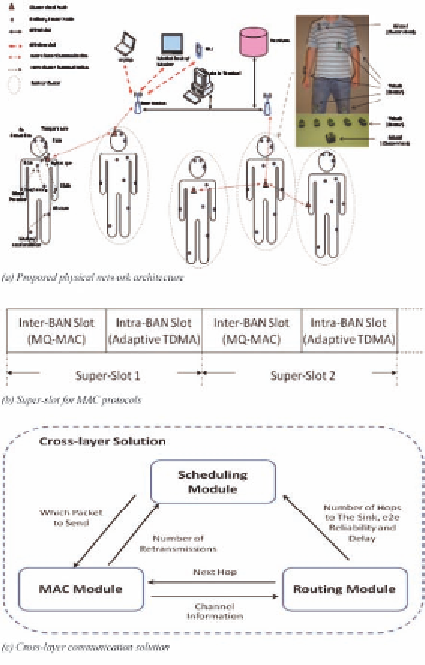Information Technology Reference
In-Depth Information
Figure 1. Proposed network architecture and
cross-layer solution
the patient the BAN is associated with. The whole
networking system is designed to be a
two-tier
hierarchical architecture
with the high-level tier
being the network of BANs (inter-BAN) and the
low-level tier being the network of biomedical
sensors attached to different body sites on one
patient (intra-BAN). Inside each BAN, a node
with higher computing power, battery power, and
networking capabilities is selected to play the
logic role
of Cluster Head (CH). This cluster head
collects, aggregates, and fuses the data from other
sensors in the cluster, performs data-consistency
checks, and transmits the processed data to the
best base station. The wireless station will then
relay the data to a mobile terminal such as laptop,
PDA, or medical device, or to a static terminal.
Cluster heads, base stations, and mobile and static
terminals can also forward each others' packets,
share each others' patient information, and access
database to obtain, if needed, the patient profile,
i.e., the patient medical history.
This two-tier architecture calls for
two differ-
ent protocol stacks
, one for
intra-BAN
and the
other for
inter-BAN
communications. The inter-
BAN protocol provides communication between
BANs, while the intra-BAN protocol is employed
to aggregate vital signs of one patient. In this
chapter, we focus on the communications from
the BANs to the base stations so cluster heads are
assumed to be pre-selected and sinks/destination
nodes are assumed to be the base stations.
To avoid EMI, inter-BAN communications
employ multiple frequency channels. However,
the operations are complicated. On the other hand,
sensors in a cluster do not need to communicate
with other clusters and are relative static. To re-
duce communication complexity and overhead,
the intra-BAN protocol is designed to be simple
while aiming at minimizing energy consumption
and reducing interference among inter-BAN
communications. We give a brief introduction of
it here, while the rest of the article will focus on
inter-BAN communications.
To seamlessly integrate the inter-BAN and
intra-BAN protocols, we adopt super-slots (Figure
1(b)), each of which is divided into two parts: the
first part (Inter-BAN slot) with Multi-channel
Quality-based MAC (MQ-MAC) scheme (Sect.
4.2) for inter-BAN packets and the second part
(Intra-BAN slot) with adaptive Time Division
Multiple Access (TDMA) scheme for intra-BAN
packets. FTSP (Maroti, Kusy, Simon, & Ledeczi,
2004), a network synchronization protocol that is
implemented and included in TinyOS 2.1, is used
to synchronize the slots.
When the intra-BAN protocol starts, all the
sensors in one BAN probe the channels by sending
out short messages during intra-BAN slots. Upon
reception of these probing messages, CH collects

Search WWH ::

Custom Search